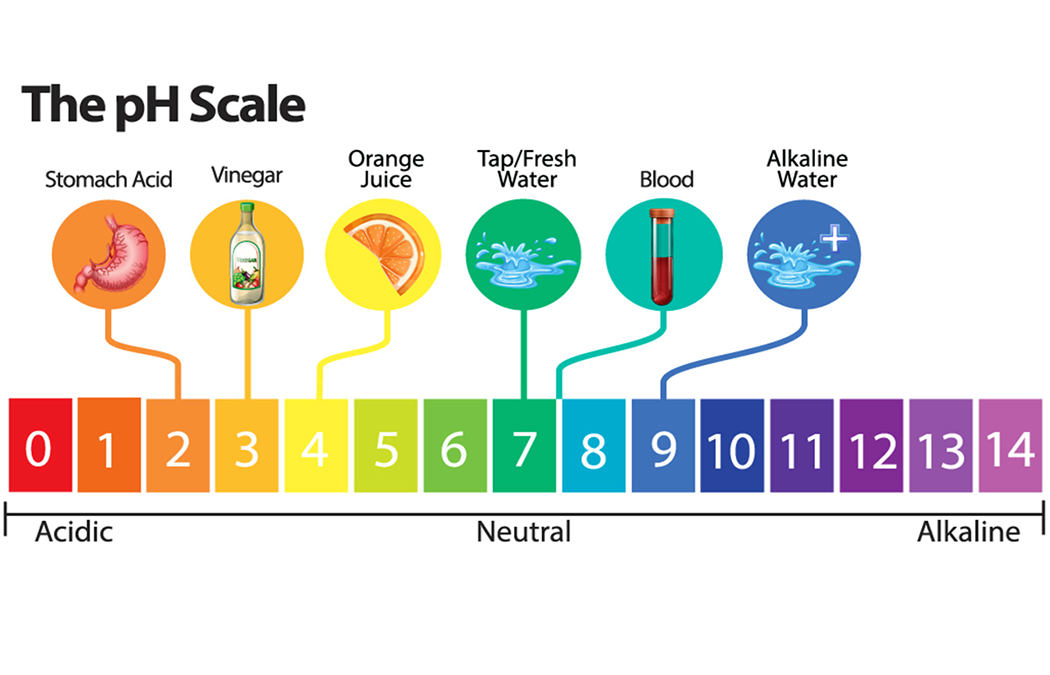Acidity vs. Alkalinity in the Body

What is High Acidity?
The term acidity describes a condition where the body is affected by the excess production of gastric acids. Under normal conditions, hydrochloric acid is secreted by the stomach, aiding in the digestion and breakdown of food.
However, when this normal process is triggered in such a way that it causes overproduction of the acid, it can result in health problems. Acidity can be caused by irregular eating patterns, fad diets, alcohol consumption, stress, smoking, an unhealthy diet, and a sedentary lifestyle. Symptoms can include:
- Indigestion
- Burning in the stomach
- Belching
- Sour taste
- Burning in the throat
- Constipation
- Nausea
- Restlessness
What Are the Dangers of High Acidity in the Body?
When the body is acidic, it can affect everything from immunity to neurological function to bone health. The Japanese have linked acidity to degenerative diseases like arthritis, cancer, and osteoporosis.
An acidic body is also a very hospitable environment for bacteria and viruses to thrive meaning the person will often get sick more often. When the body is out of balance it becomes susceptible to conditions as simple as dandruff and as complex as diabetes. Interestingly, many people have reversed or gone into remission by simply bringing their body into balance.
What is Alkalinity?
In order to understand alkalinity, you need to understand pH levels. This is the measure used to determine how alkaline or acidic something is. A pH of 0 is at the acidic end of the scale and means the thing being measured is completely acidic. At the other end of the scale, a pH of 14 is totally alkaline. The neutral point is a pH of 7.
Different parts of the body have different pH levels, meaning that some parts are more acidic while others are more alkaline. For instance, blood typically has a pH that is between 7.35 and 7.45, making it slightly alkaline. The stomach, on the other hand, is highly acidic, registering a pH of 3.5 or lower. Making the body more alkaline is not about making it completely alkaline – you need some acidity; it is necessary for digestion and other processes – it is more about bringing the body into balance.
What Are the Benefits of Alkalinity?
When the body has increased alkalinity, bringing it into a better pH balance, it is healthier and has a decreased risk of chronic illness. There is also less likelihood of illness. When the body is in a better pH balance it can result in many benefits including:
- More energy
- Improved cognitive function
- Slowed aging process
- Weight loss
- Lower cancer risk
- Decreased risk of chronic illness
- Increased immunity
How Can You Bring Your Body Into Balance?
The best way to bring your body into better pH balance is by modifying your diet. As a rule of thumb, animal-based foods like meat, eggs, and dairy tend to be more acidic. A vegetarian diet rich in plant-based foods like vegetables and fruits tend to be more alkaline. While the body does need a diet that includes both acidic and alkaline foods, a diet of processed foods and foods high in fat and sugar can cause too much acidity. By adjusting your diet, eliminating processed foods, and maintaining a healthier, more vegetarian-based diet, you can bring your body into balance and enjoy better health as a result.
Alkalizing Foods Include:
Alfalfa Alkaline Antioxidant All Berries All Herbs Almonds Apple Apple Cider Apricot Asparagus Avocado Banana Banchi Tea Barley Grass Bee Pollen Beets Broccoli Brussel sprouts Cabbage Cantaloupe Carrot Cauliflower Celery Chard Cherries Chestnuts Chicken Breast Chili Pepper Chlorella Cinnamon Collard Greens Cottage Cheese Cucumber Currants Curry Dandelion Tea Dandelions Dates/Figs Dulce Edible Flowers Eggplant Eggs Fermented Veggies Flax Seeds Fresh Fruit Juice Garlic Ginger Ginseng Tea Grapefruit Grapes Green Juices Green Tea Herbal Tea Honeydew Melon Kale Kohlrabi Kombucha Lecithin Granules Lemon Lettuce Lime Millet Mineral Water Miso Mushrooms Mustard Mustard Greens Nectarine Nightshade Veggies Nuts Onions Orange Organic Milk (unpasteurized) Parsnips Peach Pear Peas Peppers Pineapple Probiotic Cultures Pumpkin Pumpkin Seeds Rutabaga Sea Salt Sea Veggies Spirulina Sprouted Seeds Sprouts Squash Seeds Squashes Stevia Sunflower Seeds Tamari Tangerine Tempeh (fermented) Tofu (fermented) Tomato Tropical Fruits Veggies Juices Vinegar Water Watercress Watermelon Wheat Grass Whey Protein Powder Wild Greens Yogurt
Acidifying Foods Include:
Alcohol Almond Milk Amaranth Avocado Oil Barley Beef Beer Black Beans Brazil Nuts Buckwheat Butter Chemicals Canola Oil Carp Cashews Cheese, Cow Cheese, Goat Cheese, Processed Cheese, Sheep Chick Peas Clams Corn Corn Oil Cranberries Distilled Vinegar Fats & Oils Fruits Fish Flax Oil Grains Green Peas Hard Liquor Hemp Seed Flour Hemp Seed Oil Kamut Kidney Beans Lamb Lard Lentils Lima Beans Lobster Macaroni Milk Mussels Noodles Oats (Rolled) Olive Oil Oyster Pasta (White) Peanut Butter Peanuts Pecans Pesticides Pinto Beans Pork Potatoes Quinoa Rabbit Red Beans Rice (All) Rice Cakes Rice Milk Rye Safflower Oil Salmon Scallops Sesame Oil Shrimp Soy Beans Soy Milk Spaghetti Spelt Spirits Sunflower Oil Tahini Tuna Turkey Venison Walnuts Wheat Wheat Cakes Wheat Germ White Beans Wine





Leave a comment